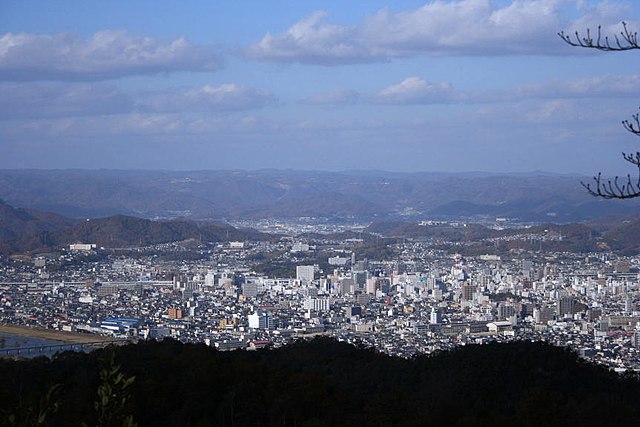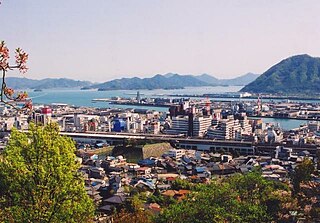Hiroshima Prefecture
Prefecture of Japan From Wikipedia, the free encyclopedia
Prefecture of Japan From Wikipedia, the free encyclopedia
Hiroshima Prefecture (広島県, Hiroshima-ken) is a prefecture of Japan located in the Chūgoku region of Honshu.[2] Hiroshima Prefecture has a population of 2,811,410 (1 June 2019) and has a geographic area of 8,479 km² (3,274 sq mi). Hiroshima Prefecture borders Okayama Prefecture to the east, Tottori Prefecture to the northeast, Shimane Prefecture to the north, and Yamaguchi Prefecture to the southwest.
Hiroshima Prefecture
広島県 | |
|---|---|
| Japanese transcription(s) | |
| • Japanese | 広島県 |
| • Rōmaji | Hiroshima-ken |
Hiroshima Oyster | |
 | |
| Country | |
| Region | Chūgoku (San'yō) |
| Island | Honshu |
| Capital | Hiroshima |
| Subdivisions | Districts: 5, Municipalities: 23 |
| Government | |
| • Governor | Hidehiko Yuzaki (since November 2009) |
| Area | |
• Total | 8,479.63 km2 (3,274.00 sq mi) |
| • Rank | 11th |
| Population (June 1, 2019) | |
• Total | 2,811,410 |
| • Rank | 12th |
| • Density | 330/km2 (860/sq mi) |
| • Dialects | Aki・Bingo |
| GDP | |
| • Total | JP¥ 11,969 billion US$ 109.8 billion (2019) |
| ISO 3166 code | JP-34 |
| Website | pref.hiroshima.lg.jp |
| Symbols of Japan | |
| Bird | Red-throated diver (Gavia stellata) |
| Tree | Japanese maple (Acer palmatum) |
Hiroshima is the capital and largest city of Hiroshima Prefecture, and the largest city in the Chūgoku region, with other major cities including Fukuyama, Kure, and Higashihiroshima.[3] Hiroshima Prefecture is located on the Seto Inland Sea across from the island of Shikoku, and is bounded to the north by the Chūgoku Mountains. Hiroshima Prefecture is one of the three prefectures of Japan with more than one UNESCO World Heritage Site.
The area around Hiroshima was formerly divided into Bingo Province and Aki Province.[4] This location has been a center of trade and culture since the beginning of Japan's recorded history. Hiroshima is a traditional center of the Chūgoku region and was the seat of the Mōri clan until the Battle of Sekigahara.
Together with Nara and Tokyo, Hiroshima is one of the three prefectures with more than one UNESCO World Heritage Site. The two such sites in Hiroshima Prefecture are:





Hiroshima prefecture lies in the middle of Japan. Most of the prefecture consists of mountains leading towards Shimane Prefecture; and rivers produce rich plains near the coast.
The province faces Shikoku across the Seto Inland Sea. Hiroshima Bay opens on the Inland Sea.[5] The prefecture also includes many small islands.
The sheltered nature of the Inland Sea makes Hiroshima's climate very mild.
As of 1 April 2014, 4% of the total land area of the prefecture was designated as Natural Parks (the lowest percentage of any prefecture), namely Setonaikai National Park; Hiba-Dōgo-Taishaku and Nishi-Chūgoku Sanchi Quasi-National Parks; and six Prefectural Natural Parks.[6]
Fourteen cities are located in Hiroshima Prefecture:
| Name | Area (km2) | Population | Map | |
|---|---|---|---|---|
| Rōmaji | Kanji | |||
| 安芸高田市 | 538.17 | 31,565 | ||
| 江田島市 | 100.97 | 24,596 | ||
| 府中市 | 195.71 | 43,932 | ||
| 福山市 | 518.14 | 468,812 | ||
| 廿日市市 | 489.36 | 117,106 | ||
| 東広島市 | 635.32 | 185,418 | ||
| 広島市 | 906.68 | 1,199,391 | ||
| 呉市 | 352.8 | 228,030 | ||
| 三原市 | 471.03 | 97,324 | ||
| 三次市 | 778.19 | 53,616 | ||
| 尾道市 | 284.85 | 141,811 | ||
| 大竹市 | 78.57 | 27,684 | ||
| 庄原市 | 1,246.6 | 35,870 | ||
| 竹原市 | 118.3 | 26,035 | ||
These are the towns in each district:
| Name | Area (km2) | Population | District | Type | Map | |
|---|---|---|---|---|---|---|
| Rōmaji | Kanji | |||||
| 安芸太田町 | 342.25 | 6,585 | Yamagata District | Town | ||
| 府中町 | 10.45 | 52,056 | Aki District | |||
| 神石高原町 | 381.81 | 9,427 | Jinseki District | |||
| 海田町 | 13.81 | 29,082 | Aki District | |||
| 北広島町 | 645.86 | 19,115 | Yamagata District | |||
| 熊野町 | 33.62 | 24,000 | Aki District | |||
| 大崎上島町 | 43.24 | 7,801 | Toyota District | |||
| 坂町 | 15.64 | 13,265 | Aki District | |||
| 世羅町 | 278.29 | 19,213 | Sera District | |||
| Year | Pop. | ±% p.a. |
|---|---|---|
| 1890 | 1,319,507 | — |
| 1903 | 1,508,713 | +1.04% |
| 1913 | 1,691,699 | +1.15% |
| 1920 | 1,541,905 | −1.32% |
| 1925 | 1,617,680 | +0.96% |
| 1930 | 1,692,136 | +0.90% |
| 1935 | 1,804,916 | +1.30% |
| 1940 | 1,869,504 | +0.71% |
| 1945 | 1,885,471 | +0.17% |
| 1950 | 2,081,967 | +2.00% |
| 1955 | 2,149,044 | +0.64% |
| 1960 | 2,184,043 | +0.32% |
| 1965 | 2,281,146 | +0.87% |
| 1970 | 2,436,135 | +1.32% |
| 1975 | 2,646,324 | +1.67% |
| 1980 | 2,739,161 | +0.69% |
| 1985 | 2,819,200 | +0.58% |
| 1990 | 2,849,847 | +0.22% |
| 1995 | 2,881,748 | +0.22% |
| 2000 | 2,878,915 | −0.02% |
| 2005 | 2,876,642 | −0.02% |
| 2010 | 2,860,750 | −0.11% |
| 2015 | 2,844,963 | −0.11% |
| source:[7] | ||
Hiroshima's main industries include automobiles (Mazda is headquartered there) and tourism in two World Heritage Sites: the A-Bomb dome and Itsukushima Shrine.
Components of the economy are primary industry, secondary industry, and tertiary industry, which compose 0.6%, 32.6%, and 66.2% in 2015. There is 0.6% of unclassified production.[8]
Value of production of manufacturing is 10,343 billion yen in 2016, which is the 10th largest in Japan. After 2012, production of manufacturing is continuously increasing in 2015.[9]
Religious denominations in the Hiroshima Prefecture (1996)[10]
Similar to the rest of Japan, most people in the Hiroshima Prefecture are Shinto or Buddhist. in 1996 51.2% of the population was Buddhist, 2% were affiliated with Shinto Sects, 44.8% practiced Folk Shinto, and 2% were Christian.[10]




The sports teams listed below are based in Hiroshima.
American Football
Seamless Wikipedia browsing. On steroids.
Every time you click a link to Wikipedia, Wiktionary or Wikiquote in your browser's search results, it will show the modern Wikiwand interface.
Wikiwand extension is a five stars, simple, with minimum permission required to keep your browsing private, safe and transparent.